Horn of Africa
| Horn of Africa | |
|---|---|
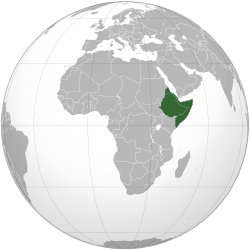 | |
| Countries |
2 unrecognised states |
| Population | 140,683,144 (2020 est.) |
| Area | 1,882,757 km2 |
TheHorn of Africa(HoA), also known as theSomali Peninsula,[2][3][4]is a largepeninsulaandgeopoliticalregion inEast Africa.[5]Located on the easternmost part of theAfricanmainland, it is the fourth largest peninsula in the world. It is composed ofSomalia(including thede factoindependentSomalilandandPuntland),Djibouti,Ethiopia,andEritrea.[6][7]Although not common, broader definitions include parts or all ofKenyaandSudan.[8][9][10]It has been described as a region of geopolitical and strategic importance, since it is situated along the southern boundary of theRed Sea;extending hundreds of kilometres into theGulf of Aden,Guardafui Channel,andIndian Ocean,it also shares a maritime border with theArabian Peninsula.[11][12][13][14]
Names[edit]
This peninsula has been known by various names.Ancient GreeksandRomansreferred to it asRegio Aromaticaor Regio Cinnamonifora due to the aromatic plants found there, or as Regio Incognita owing to its uncharted territory. In ancient and medieval times, the Horn of Africa was referred to as theBilad al Barbar( "Land of the Berbers" ).[15][16][17]It is also known as theSomali Peninsula,or in the Somali language asGeeska Afrika orJasiiradda Soomaali.[18]In other local languages it is called "Horn of Africa" or the "African Horn", inAmharicየአፍሪካ ቀንድyäafrika qänd,inArabicالقرن الأفريقيal-qarn al-'afrīqī,inOromoGaanfaa Afrikaa,and inTigrinyaቀርኒ ኣፍሪቃq'ärnī afīrīqa.[19][20]
Description[edit]
The Horn of Africa Region consists of the internationally recognized countries ofDjibouti,Eritrea,Ethiopia,andSomalia.[16][17][21][22]
Geographically the protruding shape that resembles a "Horn" consists of the "Somali peninsula" and eastern part of Ethiopia. But the region encompasses also the rest of Ethiopia, Eritrea and Djibouti.[23][24][25][26]Broader definitions includeKenyaandSudan.[27]The term Greater Horn Region (GHR) can additionally includeSouth SudanandUganda.[28]The termGreater Horn of Africais sometimes used to be inclusive of neighbouringsoutheast Africancountries to distinguish the broader geopolitical definition of the Horn of Africa from narrower peninsular definitions.[20][29][30]

The name Horn of Africa is sometimes shortened toHoA.Quite commonly it is referred to simply as "the Horn", while inhabitants are sometimes colloquially termedHorn AfricansorHorners.[19][20]Regional studies on the Horn of Africa are carried out in fields ofEthiopian studiesandSomali studies.This peninsula has been known by various names.Ancient GreeksandRomansreferred to it asRegio AromaticaorRegio Cinnamoniforadue to the aromatic plants or asRegio Incognitaowing to its uncharted territory.
History[edit]
Prehistory[edit]
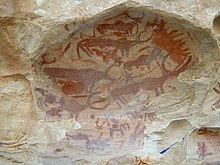
Some of the earliestHomo sapiensfossils, theOmo remains(from ca. 233,000 years ago) and theHerto skull(from ca. 160,000 ago) have been found in the region, both in Ethiopia.[33]
The findings of the Earliest Stone Tipped Projectiles from theEthiopian Riftdated to more than 279,000 years ago "in combination with the existing archaeological, fossil and genetic evidence, isolate East Africa as a source of modern cultures and biology."[34][35][36]
According to theSouthern Dispersalscenario, the Southern route of the Out of Africa migration occurred in the Horn of Africa through theBab el Mandeb.Today at the Bab-el-Mandeb straits, the Red Sea is about 12 miles (19 kilometres) wide, but 50,000 years ago it was much narrower and sea levels were 70 meters lower. Though the straits were never completely closed, there may have been islands in between which could be reached using simple rafts. Shellmiddens125,000 years old have been found in Eritrea,[37]indicating the diet of early humans included seafood obtained bybeachcombing.
Ethiopian and Eritreanagricultureestablished the earliest known use of the seed grassteff(Poa abyssinica) between 4000 and 1000 BCE.[38]Teff is used to make the flatbreadinjera/taita.Coffeealso originated in Ethiopia and has since spread to become a worldwide beverage.[39]
HistorianChristopher Ehret,cited genetic evidence which had identified the Horn of Africa as a source of a genetic marker "M35/215"Y-chromosome lineage for a significant population component which moved north from that region into Egypt and the Levant. Ehret argued that this genetic distribution paralleled the spread of theAfrasian language familywith the movement of people from the Horn of Africa into Egypt and added a new demic component to the existing population of Egypt 17,000 years ago.[40]
Ancient history[edit]
The area comprisingSomalia,Djibouti,theRed Seacoast ofEritreaandSudanis considered the most likely location of the land known to the ancientEgyptiansasPunt(or "Ta Netjeru", meaning god's land), whose first mention dates to the 25th century BCE.[41]
Dʿmtwas a kingdom located in Eritrea and northernEthiopia,which existed during the 8th and 7th centuries BCE. With its capital probably atYeha,the kingdom developedirrigationschemes, usedplows,grewmillet,and madeirontools and weapons. After the fall of Dʿmt in the 5th century BCE, the plateau came to be dominated by smaller successor kingdoms, until the rise of one of these kingdoms during the 1st century, theAksumite Kingdom,which was able to reunite the area.[42]
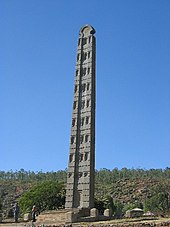
TheKingdom of Aksum(also known as the Aksumite Empire) was an ancient state located in theEritreaandEthiopian highlands,which thrived between the 1st and 7th centuries CE. A major player in the commerce between theRoman EmpireandAncient India,Aksum's rulers facilitated trade by minting their owncurrency.The state also established itshegemonyover the decliningKingdom of Kushand regularly entered the politics of the kingdoms on theArabian peninsula,eventually extending its rule over the region with the conquest of theHimyarite Kingdom.UnderEzana(fl. 320–360), the kingdom of Aksum became the first major empire to adoptChristianity,and was named byManias one of the four great powers of his time, along withPersia,RomeandChina.
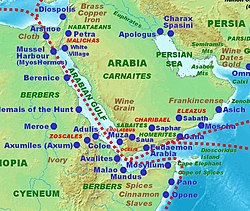
Somalia was an important link in the Horn, connecting the region's commerce with the rest of the ancient world. Somali sailors and merchants were the main suppliers offrankincense,myrrhand spices, all of which were valuable luxuries to theAncient Egyptians,Phoenicians,Mycenaeans,BabyloniansandRomans.[43][44]The Romans consequently began to refer to the region asRegio Aromatica.In theclassical era,several flourishingSomali city-statessuch asOpone,MosylonandMalaoalso competed with theSabaeans,ParthiansandAxumitesfor the richIndo-Greco-Romantrade.[45]
Thebirth of Islamopposite the Horn's Red Sea coast meant that local merchants and sailors living on theArabian Peninsulagradually came under the influence of the new religion through their convertedArabMuslim trading partners. With the migration of Muslim families from theIslamic worldto the Horn in the early centuries of Islam, and the peaceful conversion of the local population by Muslim scholars in the following centuries, the ancient city-states eventually transformed into IslamicMogadishu,Berbera,Zeila,BarawaandMerka,which were part of theBarbara civilization.[46][47]The city of Mogadishu came to be known as the "City of Islam"[48]and controlled the East African gold trade for several centuries.[49]
Middle Ages and Early Modern era[edit]


During theMiddle Ages,several powerful empires dominated the regional trade in the Horn, including theAdal Sultanate,theAjuran Sultanate,theEthiopian Empire,theZagwe dynasty,and theSultanate of the Geledi.
TheSultanate of Showa,established in 896, was one of the oldest localIslamicstates. It was centered in the formerShewaprovince in central Ethiopia. The polity was succeeded by theSultanate of Ifataround 1285. Ifat was governed from its capital atZeilain Somaliland and was the easternmost district of the former Shewa Sultanate.[50]
TheAdal Sultanatewas a medieval multi-ethnicMuslimstate centered in the Horn region. At its height, it controlled large parts of Somalia, Ethiopia, Djibouti and Eritrea. Many of the historic cities in the region, such asAmud,Maduna,Abasa,Berbera,ZeilaandHarar,flourished during the kingdom's golden age. This period that left behind numerouscourtyard houses,mosques,shrinesandwalled enclosures.Under the leadership of rulers such asSabr ad-Din II,Mansur ad-Din,Jamal ad-Din II,Shams ad-Din,GeneralMahfuzandAhmad ibn Ibrahim al-Ghazi,Adalite armies continued the struggle against theSolomonic dynasty,a campaign historically known as theConquest of AbyssiniaorFutuh al Habash.
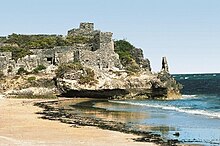
Through a strong centralized administration and an aggressive military stance towards invaders, theAjuran Sultanatesuccessfully resisted anOromoinvasion from the west and aPortugueseincursion from the east during theGaal Madowand theAjuran-Portuguese wars.Trading routes dating from the ancient and early medieval periods ofSomali maritime enterprisewere also strengthened or re-established, and the state left behind an extensivearchitectural legacy.Many of the hundreds of ruined castles and fortresses that dot the landscape of Somalia today are attributed to Ajuran engineers,[51]including a lot of thepillar tombfields,necropolisesand ruined cities built during that era. The royal family, theHouse of Gareen,also expanded its territories and established its hegemonic rule through a skillful combination of warfare, trade linkages and alliances.[52]
TheZagwe dynastyruled many parts of modern Ethiopia and Eritrea from approximately 1137 to 1270. The name of the dynasty comes from theCushitic-speakingAgaw peopleof northern Ethiopia. From 1270 onwards for many centuries, theSolomonic dynastyruled theEthiopian Empire.
In 1270, theAmharanoblemanYekuno Amlak,who claimed descent from the lastAksumiteking and ultimately theQueen of Sheba,overthrew theAgawZagwe dynastyat theBattle of Ansata,ushering his reign asEmperor of Ethiopia.While initially a rather small and politically unstable entity, the empire managed to expand significantly during thecrusadesofAmda Seyon I(1314–1344) and his successors, becoming the dominant force inEast Africa.[53][54]
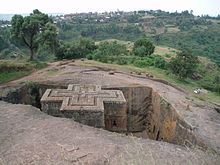
In the early 15th century, Ethiopia sought to make diplomatic contact with European kingdoms for the first time since Aksumite times. A letter from KingHenry IV of Englandto the Emperor of Abyssinia survives.[55]In 1428, the EmperorYeshaqsent two emissaries toAlfonso V of Aragon,who sent return emissaries who failed to complete the return trip.[56]
The first continuous relations with a European country began in 1508 with Portugal under EmperorLebna Dengel,who had just inherited the throne from his father.[57]This proved to be an important development, for when Abyssinia was subjected to the attacks of theAdal SultanateGeneral andImamAhmad ibn Ibrahim al-Ghazi(called "Gurey"or"Grañ",both meaning" the Left-handed "), Portugal assisted the Ethiopian emperor by sending weapons and four hundred men, who helped his sonGelawdewosdefeat Ahmad and re-establish his rule.[58]ThisEthiopian–Adal Warwas also one of the first proxy wars in the region as theOttoman Empire,and Portugal took sides in the conflict.

When EmperorSusenyosconverted toRoman Catholicismin 1624, years of revolt and civil unrest followed resulting in thousands of deaths.[59]TheJesuitmissionaries had offended the Orthodox faith of the local Ethiopians. On 25 June 1632, Susenyos's son, EmperorFasilides,declared the state religion to again beEthiopian Orthodox Christianity,and expelled the Jesuit missionaries and other Europeans.[60][61]
During the end of 18th and the beginning of 19th century the Yejju dynasty (more specifically, the Warasek) ruled north Ethiopia changing the official language of Amhara people to Afaan Oromo, including inside the court of Gondar which was capital of the empire. Founded byAli I of Yejjuseveral successive descendants of him andAbba Seru Gwangulruled with their army coming from mainly their clan theYejju Oromo tribeas well as Wollo and Raya Oromo.[62]

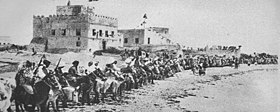
TheSultanate of the Gelediwas a Somali kingdom administered by the Gobroon dynasty, which ruled parts of the Horn of Africa during the 18th and 19th centuries. It was established by the Ajuran soldierIbrahim Adeer,who had defeated variousvassalsof the Ajuran Empire and established theHouse of Gobroon.Thedynastyreached its apex under the successive reigns of SultanYusuf Mahamud Ibrahim,who successfully consolidated Gobroon power during theBardera wars,and SultanAhmed Yusuf,who forced regional powers such as theOmani Empireto submittribute.
TheIsaaq Sultanatewas aSomalikingdom that ruled parts of the Horn of Africa during the 18th and 19th centuries. It spanned the territories of theIsaaqclan, descendants of theBanu Hashimclan,[63]in modern-daySomalilandandEthiopia.The sultanate was governed by theReer Guledbranch of theEidagalesub-clan established by the first sultan, SultanGuled Abdi.The sultanate is the pre-colonial predecessor to the modernSomaliland.[64][65][66]
According to oral tradition, prior to the Guled dynasty theIsaaqclan-family were ruled by a dynasty of the Tolje'lo branch starting from, descendants of Ahmed nicknamed Tol Je'lo, the eldest son ofSheikh Ishaaq'sHarariwife. There were eight Tolje'lo rulers in total, starting with Boqor Harun (Somali:Boqor Haaruun) who ruled the Isaaq Sultanate for centuries starting from the 13th century.[67][68]The last Tolje'lo rulerGaradDhuh Barar (Somali:Dhuux Baraar) was overthrown by a coalition of Isaaq clans. The once strong Tolje'lo clan were scattered and took refuge amongst theHabr Awalwith whom they still mostly live.[69][70]
TheMajeerteen Sultanate(Migiurtinia) was another prominent Somali sultanate based in the Horn region. Ruled byKingOsman Mahamuudduring its golden age, it controlled much of northeastern and central Somalia in the 19th and early 20th centuries. The polity had all of the organs of an integrated modern state and maintained a robust trading network. It also entered into treaties with foreign powers and exerted strong centralized authority on the domestic front.[71][72]Much of the Sultanate's former domain is today coextensive with the autonomousPuntlandregion in northern Somalia.[73]
TheSultanate of Hobyowas a 19th-century Somali kingdom founded by SultanYusuf Ali Kenadid.Initially, Kenadid's goal was to seize control of the neighboring Majeerteen Sultanate, which was then ruled by his cousin Boqor Osman Mahamuud. However, he was unsuccessful in this endeavor, and was eventually forced into exile inYemen.A decade later, in the 1870s, Kenadid returned from theArabian Peninsulawith a band ofHadhramimusketeersand a group of devoted lieutenants. With their assistance, he managed to establish the kingdom of Hobyo, which would rule much of northern and central Somalia during the early modern period.[74]
Modern history[edit]
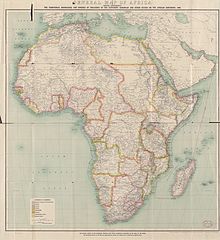

In the period following the opening of theSuez Canalin 1869, when European powersscrambled for territory in Africaand tried to establishcoaling stationsfor their ships, Italy invaded and occupiedEritrea.On 1 January 1890, Eritrea officially became a colony ofItaly.In 1896 further Italian incursion into the horn was decisively halted by Ethiopian forces. By 1936 however, Eritrea became aprovinceofItalian East Africa(Africa Orientale Italiana), along withEthiopiaandItalian Somaliland.By 1941, Eritrea had about 760,000 inhabitants, including 70,000 Italians.[75]The Commonwealth armed forces, along with the Ethiopian patriotic resistance, expelled those of Italy in 1941,[76]and took over the area's administration. The British continued to administer the territory under aUN Mandateuntil 1951, when Eritrea was federated with Ethiopia, per UN resolution 390 A (V) adopted December 1950.
The strategic importance of Eritrea, due to itsRed Seacoastline and mineral resources, was the main cause for the federation with Ethiopia, which in turn led to Eritrea's annexation as Ethiopia's 14th provincein 1962.This was the culmination of a gradual process of takeover by the Ethiopian authorities, a process which included a 1959 edict establishing the compulsory teaching ofAmharic,the main language of Ethiopia, in all Eritrean schools. The lack of regard for the Eritrean population led to the formation of an independence movement in the early 1960s (1961), which erupted into a30-year waragainst successive Ethiopian governments that ended in 1991. Following a UN-supervisedreferendumin Eritrea (dubbedUNOVER) in which the Eritrean people overwhelmingly voted for independence, Eritrea declared its independence and gained international recognition in 1993.[77]In 1998, a border dispute with Ethiopia led to theEritrean-Ethiopian War.[78]

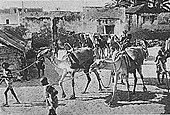
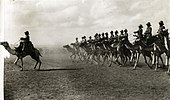


From 1862 until 1894, the land to the north of theGulf of Tadjourasituated in modern-dayDjiboutiwas calledObockand was ruled bySomaliandAfarSultans,local authorities with whomFrancesigned various treaties between 1883 and 1887 to first gain a foothold in the region.[79][80][81]In 1894,Léonce Lagardeestablished a permanent French administration in thecity of Djiboutiand named the regionCôte française des Somalis(French Somaliland), a name which continued until 1967.
In 1958, on the eve of neighboringSomalia's independence in 1960, areferendumwas held in the territory to decide whether to join the Somali Republic or to remain with France. The referendum favoured continued association with France, partly due to a combined yes vote by the sizable Afar ethnic group and resident Europeans.[82]There was also reports of widespreadvote rigging,with the French expelling thousands of Somalis before the polls.[83]The majority of those who voted no were Somalis who were strongly in favour of joining a united Somalia, as had been proposed byMahmoud Harbi,Vice President of the Government Council. Harbi was killed in a plane crash two years later.[82]Djibouti finally gained its independence from France in 1977.Hassan Gouled Aptidon,a Somali politician who had campaigned for a yes vote in the referendum of 1958, became the nation's first president (1977–1999).[82]In early 2011, the Djiboutian citizenry took part in aseries of protestsagainst the long-serving government, which were associated with the largerArab Springdemonstrations. The unrest eventually subsided by April of the year, and Djibouti's rulingPeople's Rally for Progressparty was re-elected to office.
TheDervishexisted for 25 years, from 1895 until 1920. TheTurksnamed HassanEmirof the Somali nation,[84]and theGermanspromised to officially recognize any territories the Dervishes were to acquire.[85]After a quarter of a century of holding the British at bay, the Dervishes were finally defeated in 1920 as a direct consequence of Britain's new policy ofaerial bombardment.[86]As a result of this bombardment, former Dervish territories were turned into aprotectorateof Britain.Italyfaced similar opposition from SomaliSultansand armies, and did not acquire full control of modern Somalia until theFascist erain late 1927. This occupation lasted until 1941, and was replaced by aBritishmilitary administration.Former British Somaliland would remain, along with Italian Somaliland, atrusteeshipof Italy, between 1950 and 1960. The Union of the two countries in 1960 formed the Somali Republic. A civilian government was formed, and on 20 July 1961, through a popularreferendum,theconstitutiondrafted in 1960 was ratified.[87]
Due to its longstanding ties with theArab world,the Somali Republic was accepted in 1974 as a member of theArab League.[88]During the same year, the nation's formersocialistadministration also chaired theOrganization of African Unity,the predecessor of theAfrican Union.[89]In 1991, theSomali Civil Warbroke out, which saw the dissolving of the union and Somaliland regaining its independence, along with the collapse of the central government and the emergence of numerous autonomous polities, including thePuntlandadministration in the north.[90]Somalia's inhabitants subsequently reverted to local forms of conflict resolution, eithersecular,Islamicorcustomary law,with a provision for appeal of all sentences. ATransitional Federal Governmentwas subsequently created in 2004.[91]TheFederal Government of Somaliawas established on 20 August 2012, concurrent with the end of the TFG's interim mandate.[92]It represents the first permanent central government in the country since the start of the civil war.[92]TheFederal Parliament of Somaliaserves as the government'slegislativebranch.[93]
Modern Ethiopia and its current borders are a result of significant territorial reduction in the north and expansion in the east and south toward its present borders, owing to several migrations, commercial integration, treaties as well as conquests, particularly byEmperor Menelik IIandRas Gobena.[94]From the central province of Shoa, Menelik set off to subjugate and incorporate 'the lands and people of the South, East and West into an empire.'[94][95]He did this with the help of Ras Gobena's Shewan Oromo militia, began expanding his kingdom to the south and east, expanding into areas that had not been held since the invasion ofAhmad ibn Ibrihim al-Ghazi,and other areas that had never been under his rule, resulting in the borders of Ethiopia of today.[96]Menelik had signed theTreaty of Wichalewith Italy in May 1889, in which Italy would recognize Ethiopia's sovereignty so long as Italy could control a small area of northern Tigray (part of modern Eritrea).[97]In return, Italy was to provide Menelik with arms and support him as emperor.[98]The Italians used the time between the signing of the treaty and its ratification by the Italian government to further expand their territorial claims. Italy began a state funded program of resettlement for landless Italians in Eritrea, which increased tensions between the Eritrean peasants and the Italians.[98]This conflict erupted in theBattle of Adwaon 1 March 1896, in which Italy's colonial forces were defeated by the Ethiopians.[99]
The early 20th century in Ethiopia was marked by the reign of EmperorHaile Selassie I,who came to power afterIyasu Vwas deposed. In 1935, Haile Selassie's troops fought and lost theSecond Italo-Abyssinian War,after which Italy annexed Ethiopia toItalian East Africa.[100]Haile Selassie subsequently appealed to theLeague of Nations,delivering an address that made him a worldwide figure and 1935'sTimemagazine Man of the Year.[101]Following the entry of Italy into World War II,British Empireforces, together with patriot Ethiopian fighters, liberated Ethiopia during theEast African Campaignin 1941.[102]
Haile Selassie's reign came to an end in 1974, when a Soviet-backedMarxist-Leninistmilitary junta,theDergled byMengistu Haile Mariam,deposed him, and established a one-partycommunist state,which was called thePeople's Democratic Republic of Ethiopia.In July 1977, theOgaden Warbroke out after the Somalia government ofSiad Barresought to incorporate the predominantly Somali-inhabitedOgadenregion into a Pan-SomaliGreater Somalia.By September 1977, theSomali armycontrolled 90 percent of the Ogaden, but was later forced to withdraw after Ethiopia's Derg received assistance from theUSSR,Cuba,South Yemen,East Germany[103]andNorth Korea,including around 15,000 Cuban combat troops.
In 1989, theTigrayan Peoples' Liberation Front(TPLF) merged with other ethnically based opposition movements to form theEthiopian Peoples' Revolutionary Democratic Front(EPRDF), and eventually managed to overthrow Mengistu's dictatorial regime in 1991. A transitional government, composed of an 87-member Council of Representatives and guided by a national charter that functioned as a transitional constitution, was then set up. The first free and democratic election took place later in 1995, when Ethiopia's longest-serving Prime MinisterMeles Zenawiwas elected to office. As with other nations in the Horn region, Ethiopia maintained its historically close relations with countries in the Middle East during this period of change.[104]Zenawi died in 2012, but hisEthiopian People's Revolutionary Democratic Front(EPRDF) party remains the ruling political coalition in Ethiopia.
Geography[edit]
Geology and climate[edit]
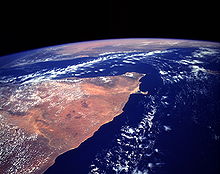
The Horn of Africa is almostequidistantfrom theequatorand theTropic of Cancer.It consists chiefly of mountains uplifted through the formation of theGreat Rift Valley,a fissure in the Earth'scrustextending fromTurkeytoMozambiqueand marking the separation of the African and Arabiantectonic plates.Mostly mountainous, the region arose through faults resulting from the Rift Valley.
Geologically, the Horn andYemenonce formed a single landmass around 18 million years ago, before theGulf of Adenrifted and separated the Horn region from theArabian Peninsula.[105][106]TheSomali Plateis bounded on the west by the East African Rift, which stretches south from thetriple junctionin theAfar Depression,and an undersea continuation of the rift extending southward offshore. The northern boundary is theAden Ridgealong the coast ofSaudi Arabia.The eastern boundary is theCentral Indian Ridge,the northern portion of which is also known as theCarlsberg Ridge.The southern boundary is theSouthwest Indian Ridge.
Extensiveglaciersonce covered theSimienandBale Mountainsbut melted at the beginning of theHolocene.[citation needed]The mountains descend in a hugeescarpmentto theRed Seaand more steadily to theIndian Ocean.Socotrais a small island in the Indian Ocean off the coast of Somalia. Its size is 3,600 km2(1,400 sq mi) and it is a territory of Yemen.
Thelowlandsof the Horn are generally arid in spite of their proximity to the equator. This is because the winds of the tropicalmonsoonsthat give seasonal rains to theSaheland theSudanblow from the west. Consequently, they lose their moisture before reaching Djibouti and northern part of Somalia, with the result that most of the Horn receives little rainfall during the monsoon season.[citation needed]
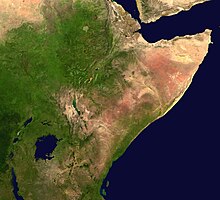
In the mountains of Ethiopia, many areas receive over 2,000 mm (79 in) per year, and evenAsmarareceives an average of 570 mm (22 in). This rainfall is the sole source of water for many areas outside Ethiopia, includingEgypt.In the winter, the northeasterlytrade windsdo not provide any moisture except in mountainous areas of northern Somalia, where rainfall in late autumn can produce annual totals as high as 500 mm (20 in). On the eastern coast, a strongupwellingand the fact that the winds blow parallel to the coast means annual rainfall can be as low as 50 mm (2.0 in).
The climate in Ethiopia varies considerably between regions. It is generally hotter in the lowlands and temperate on the plateau. AtAddis Ababa,which ranges from 2,200 to 2,600 m (7,218 to 8,530 ft), maximum temperature is 26 °C (78.8 °F) and minimum 4 °C (39.2 °F). The weather is usually sunny and dry, but the short (belg) rains occur from February to April and the big (meher) rains from mid-June to mid-September. TheDanakil Desertstretches across 100,000 km2of arid terrain in northeast Ethiopia, southern Eritrea, and northwestern Djibouti. The area is known for its volcanoes and extreme heat, with daily temperatures over 45 °C and often surpassing 50 °C. It has a number of lakes formed by lava flows that dammed up several valleys. Among these areLake Asale(116 m below sea level) andLake Giuletti/Afrera(80 m below sea level), both of which possess cryptodepressions in theDanakil Depression.The Afrera contains many active volcanoes, including the Maraho,Dabbahu,AfderaandErta Ale.[107][108]
In Somalia, there is not much seasonal variation in climate. Hot conditions prevail year-round along with periodicmonsoonwinds and irregular rainfall. Mean daily maximum temperatures range from 28 to 43 °C (82 to 109 °F), except at higher elevations along the eastern seaboard, where the effects of a cold offshore current can be felt. Somalia has only two permanent rivers, theJubbaand theShabele,both of which begin in theEthiopian Highlands.[109]
Ecology[edit]

About 220mammalsare found in the Horn of Africa. Among threatenedspeciesof the region, there are severalantelopessuch as thebeira,thedibatag,thesilver dikdikand theSpeke's gazelle.Other remarkable species include theSomali wild ass,thedesert warthog,thehamadryas baboon,theSomali pygmy gerbil,theammodile,and theSpeke's pectinator.TheGrevy's zebrais the unique wildequidof the region. There are predators such asspotted hyena,striped hyenaandAfrican leopard.Theendangeredpainted hunting doghad populations in the Horn of Africa, but pressures from human exploitation of habitat along with warfare have reduced or extirpated this canid in this region.[110]
Some important bird species of the Horn are theblack boubou,thegolden-winged grosbeak,theWarsangli linnet,and theDjibouti spurfowl.
The Horn of Africa holds moreendemicreptilesthan any other region in Africa, with over 285 species total and about 90 species which are found exclusively in the region. Among endemic reptile genera, there areHaackgreerius,Haemodracon,Ditypophis,PachycalamusandAeluroglena.Half of these genera are uniquely found on Socotra. Unlike reptiles,amphibiansare poorly represented in the region.
There are about 100 species offreshwaterfishin the Horn of Africa, about 10 of which are endemic. Among the endemic, threecavefishes,Somali blind barb,Phreatichthys andruzziiandUegitglanis zammaranoican be found.

It is estimated that about 5,000 species ofvascular plantsare found in the Horn, about half of which are endemic. Endemism is most developed in Socotra and northern Somalia. The region has two endemic plantfamilies:theBarbeyaceaeand theDirachmaceae.Among the other remarkable species, there are thecucumber treefound only on Socotra, theBankoualé palm,theyeheb nut,and the Somalicyclamen.
Due to the Horn of Africa'ssemi-aridandaridclimate, droughts are not uncommon. They are complicated by climate change and changes in agricultural practices. For centuries, the region'spastoral groupshave observed carefulrangeland managementpractices to mitigate the effects of drought, such as avoiding overgrazing or setting aside land only for young or ill animals. However, population growth has put pressure on limited land and led to these practices no longer being maintained. Droughts in 1983–85, 1991–92, 1998–99 and 2011 have disrupted periods of gradual growth in herd numbers, leading to a decrease of between 37 and 62 percent of the cattle population. Initiatives byECHOandUSAIDhave succeeded in reclaiming hundreds of hectares of pastureland through rangeland management, leading to the establishment of the Dikale Rangeland in 2004.[111]
As of 2023, the Horn of Africa is affected by a severeongoing droughtand famine that has been going on for six consecutive years, especially in Somalia and in the months from March to May during which 60 percent of the annual rainfall occurs. It is estimated that the lives of a number of people ranging from 22[112]to 58 million[113]are at risk.
Demographics, ethnicity and languages[edit]

Besides sharing similar geographic endowments, the countries of the Horn of Africa are, for the most part, linguistically and ethnically linked together,[21]evincing a complex pattern of interrelationships among the various groups.[114]The two main macro groups in the Horn are theCushitic-speakingCushitic peoplestraditionally centered in the lowlands and theEthiosemitic-speakingHabesha peopleswho inhabit theEthiopianandEritreanhighlands.
According toEthnologue,there are 10 individual languages spoken in Djibouti (two native), 14 in Eritrea, 90 in Ethiopia, 15 in Somalia (Somali being the only native).[115]Most people in the Horn speakAfroasiatic languagesof theCushitic,Semitic,orOmoticbranches. The Cushitic branch includesOromo,spoken by theOromo peoplein Ethiopia, andSomali,spoken by theSomali peoplein Somalia, Djibouti, Ethiopia and Kenya; the Semitic branch (specifically theEthiosemiticsub-branch) includesAmharic,spoken by theAmhara peopleof Ethiopia, andTigrinyaspoken by theTigrayan peopleof Ethiopia and theTigrinya peopleof Eritrea. Other Afroasiatic languages with a significant number of speakers include the CushiticAfar,Saho,Hadiyya,SidamoandAgawlanguages, the SemiticTigre,Arabic,Gurage,Harari,Silt'eandArgobbatongues[116]as well asOmotic languagesare spoken by Omotic communities inhabiting Ethiopia's southern regions. Among these languages areAari,Dizi,Gamo,Kafa,HamerandWolaytta.[117]
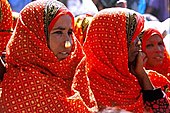

Languages belonging to theNilo-Saharanlanguage family are also spoken in some areas byNiloticethnic minorities mostly inEthiopiaandEritrea.These tongues include the Nilo-SaharanMe'enandMursilanguages used in southwestern Ethiopia, andKunamaandNaraidioms spoken in parts of southern Eritrea.
Languages belonging to theNiger-Congolanguage family are also spoken in some areas byBantuethnic minorities in Somalia. In the riverine and littoral areas of southern Somalia,Bajuni,Barawani,and Bantu groups also speak variants of the Niger-CongoSwahiliandMushungulilanguages.[118][119]
The Horn has produced numerous indigenous writing systems. Among these isGe'ez script(ግዕዝGəʿəz) (also known asEthiopic), which has been written in for at least 2000 years.[120]It is anabugidascript that was originally developed to write theGe'ez language.In speech communities that use it, such as the Amharic and Tigrinya, the script is calledfidäl(ፊደል), which means "script" or "Alpha bet". For centuries, Somali sheikhs and Sultans usedwadaad's writing(a version of the Arabic Alpha bet) to write. In the early 20th century, in response to a national campaign to settle on a writing script for theSomali language(which had long since lost its ancient script[121]),Osman Yusuf Kenadid,a Somali poet and remote cousin of theSultanYusuf Ali Kenadidof theSultanate of Hobyo,devised a phonetically sophisticated Alpha bet calledOsmanya(also known asfar soomaali;Osmanya: 𐒍𐒖𐒇 𐒈𐒝𐒑𐒛𐒐𐒘) for representing the sounds of Somali.[122]Though no longer the official writing script in Somalia, the Osmanya script is available in theUnicoderange 10480-104AF [from U+10480 – U+104AF (66688–66735)]. A number of ethnic minority groups in southern Ethiopia and Eritrea also adhere to varioustraditional faiths.Among these belief systems are the Nilo-SaharanSurma people's acknowledgment of thesky godTumu.[123]
Economy[edit]
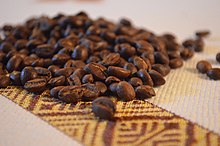
According to the IMF, in 2010 the Horn of Africa region had a total GDP (PPP) of $106.224 billion and nominal of $35.819 billion. Per capita, the GDP in 2010 was $1061 (PPP) and $358 (nominal).[124][125][126][127]
Over 95 percent of cross-border trade within the region is unofficial and undocumented, carried out by pastoralists trading livestock.[128]The unofficial trade of live cattle, camels, sheep and goats fromEthiopiasold to other countries in the Horn and the wider Eastern Africa region, includingSomaliaandDjibouti,generates an estimated total value of between US$250 and US$300 million annually (100 times more than the official figure), with the towns ofBuraoandYirowein Somaliland being home to the largest livestock markets in the Horn of Africa, with as many as 10,000 heads of sheep and goats sold daily from all over the Horn of Africa, with many of whom shipped toGulf statesvia theportofBerbera.[128][129][130][131]This trade helps lowerfood prices,increase food security, relieve border tensions and promote regional integration.[128]However, the unregulated and undocumented nature of this trade runs risks, such as allowing disease to spread more easily across national borders. Furthermore, governments are unhappy with lost tax revenue and foreign exchange revenues.[128]
See also[edit]
- Incense trade route
- List of peninsulas
- Operation Enduring Freedom – Horn of Africa
- Silk Road
- Sub-Saharan Africa
- African Great Lakes Region
Notes[edit]
References[edit]
- ^Encyclopædia Britannica, inc, Jacob E. Safra,The New Encyclopædia Britannica,(Encyclopædia Britannica: 2002), p.61: "The northern mountainous area, known as the Horn of Africa, comprises Djibouti, Ethiopia, Eritrea, and Somalia."
- ^Christy A. Donaldson (2014).Encyclopedia of World Geography – Horn of Africa.Infobase Publishing. pp. 422–424.ISBN978-0-8160-7229-3.
This area is also known as the Somali Peninsula, because within it lies the countries of Somalia and eastern Ethiopia.
- ^"Rethinking Pastoralism and African Development: a case study of the Horn of Africa"(PDF).October 2005. Archived fromthe original(PDF)on 26 March 2022.Retrieved13 December2021.
The Horn of Africa (or, Somali Peninsula) is a peninsula of Eastern Africa.
- ^Brock Millman (2013).British Somaliland An Administrative History, 1920–1960.Routledge. p. 8.ISBN978-1-317-97544-1.
- ^Robert Stock,Africa South of the Sahara, Second Edition: A Geographical Interpretation,(The Guilford Press; 2004), p. 26
- ^"The Horn of Africa - Its Strategic Importance for Europe, the Gulf States, and Beyond".CIRSD.Retrieved22 January2024.
- ^"Between Somaliland and Puntland – Rift Valley Institute".riftvalley.net.Retrieved22 June2024.
- ^John I. Saeed,Somali– Volume 10 of London Oriental and African language library, (J. Benjamins: 1999), p. 250.
- ^Sandra Fullerton Joireman,Institutional Change in the Horn of Africa,(Universal-Publishers: 1997), p.1: "The Horn of Africa encompasses the countries of Ethiopia, Eritrea, Djibouti, and Somalia. These countries share similar peoples, languages, and geographical endowments."
- ^"Horn of Africa".Encyclopædia Britannica Online.Chicago, Illinois:Encyclopædia Britannica, Inc.Archivedfrom the original on 19 December 2021.Retrieved4 April2022.
- ^"Three important oil trade chokepoints are located around the Arabian Peninsula - U.S. Energy Information Administration (EIA)".eia.gov.Archivedfrom the original on 2 April 2024.Retrieved22 January2024.
- ^"Red Sea chokepoints are critical for international oil and natural gas flows - U.S. Energy Information Administration (EIA)".eia.gov.Archivedfrom the original on 5 April 2024.Retrieved22 January2024.
- ^"Horn of Africa | Countries, Map, & Facts | Britannica".britannica.Archivedfrom the original on 19 December 2021.Retrieved19 December2021.
- ^"the Chairman of DPFZA and CEO of Red Sea Bunkering signed an investment with Afreximbank | DPFZA".dpfza.gov.dj.Archivedfrom the original on 2 April 2024.Retrieved22 January2024.
- ^J. D. Fage, Roland Oliver, Roland Anthony Oliver,The Cambridge History of Africa,(Cambridge University Press: 1977), p.190
- ^abGeorge Wynn Brereton Huntingford,Agatharchides,The Periplus of the Erythraean Sea: With Some Extracts from Agatharkhidēs "On the Erythraean Sea",(Hakluyt Society: 1980), p.83
- ^abJohn I. Saeed,Somali– Volume 10 of London Oriental and African language library, (J. Benjamins: 1999), p. 250.
- ^Ciise, Jaamac Cumar. Taariikhdii daraawiishta iyo Sayid Maxamad Cabdille Xasan, 1895–1920. JC Ciise, 2005.
- ^abTeklehaimanot, Hailay Kidu. "A Mobile Based Tigrigna Language Learning Tool." International Journal of Interactive Mobile Technologies (iJIM) 9.2 (2015): 50–53.
- ^abcSchmidt, Johannes Dragsbaek; Kimathi, Leah; Owiso, Michael Omondi (13 May 2019).Refugees and Forced Migration in the Horn and Eastern Africa: Trends, Challenges and Opportunities.Springer.ISBN978-3-030-03721-5.
- ^abSandra Fullerton Joireman,Institutional Change in the Horn of Africa,(Universal-Publishers: 1997), p.1: "The Horn of Africa encompasses the countries of Ethiopia, Eritrea, Djibouti, and Somalia. These countries share similar peoples, languages, and geographical endowments."
- ^Felter, Claire (1 February 2018)."Somaliland: The Horn of Africa's Breakaway State".Council on Foreign Relations.Archivedfrom the original on 21 November 2020.Retrieved24 March2021.It covers approximately two million square kilometers (770,000 square miles) and is inhabited by roughly 115 million people (Ethiopia: 110 million, Somalia: 15.8 million, Eritrea: 6.4 million, and Djibouti: 921.8 thousand).
- ^Aweis A Ali (May 2021)."A Brief History of Judaism in the Somali Peninsula".Archivedfrom the original on 22 May 2024.Retrieved13 August2022– viaResearchGate.
- ^"Horn of Africa".4 June 2021.Archivedfrom the original on 25 October 2022.Retrieved13 August2022.
- ^"Britannica School".Archivedfrom the original on 25 October 2022.Retrieved13 August2022.
- ^Eliezer Wangulu (6 September 2007)."Somalia: Africa Insight – Why Talk in Hotels Won't Yield Long Term Peace".The Nation.Nairobi.Archivedfrom the original on 8 June 2008.Retrieved25 August2022– viaAllAfrica.
- ^"Horn of Africa".Encyclopædia Britannica Online.Chicago, Illinois:Encyclopædia Britannica, Inc.Archivedfrom the original on 19 December 2021.Retrieved4 April2022.
- ^Regional Integration, Identity and Citizenship in the Greater Horn of Africa.Boydell & Brewer. 2012.ISBN978-1-84701-058-2.JSTOR10.7722/j.ctt1x73f1.Archivedfrom the original on 10 December 2021.Retrieved12 December2021.
- ^Schreck, Carl J., and Fredrick HM Semazzi. "Variability of the recent climate of eastern Africa." International Journal of Climatology 24.6 (2004): 681–701.
- ^"Somalia | Election, President, News, Capital, & Economy | Britannica".Archivedfrom the original on 22 January 2022.Retrieved13 August2022.
- ^Regional Integration, Identity and Citizenship in the Greater Horn of Africa.Boydell & Brewer. 2012.ISBN9781847010582.JSTOR10.7722/j.ctt1x73f1.Archivedfrom the original on 10 December 2021.Retrieved12 December2021.
- ^"Horn of Africa (Somalia, Ethiopia, Kenya)".Archivedfrom the original on 10 December 2021.Retrieved12 December2021.
- ^Vidal, Celine M.;Lane, Christine S.;Asfawrossen, Asrat; et al. (January 2022)."Age of the oldest known Homo sapiens from eastern Africa".Nature.601(7894): 579–583.Bibcode:2022Natur.601..579V.doi:10.1038/s41586-021-04275-8.PMC8791829.PMID35022610.
- ^Sahle, Yonatan; Hutchings, W. Karl; Braun, David R.; Sealy, Judith C.; Morgan, Leah E.; Negash, Agazi; Atnafu, Balemwal (13 November 2013)."Earliest Stone-Tipped Projectiles from the Ethiopian Rift Date to >279,000 Years Ago".PLOS ONE.8(11): e78092.Bibcode:2013PLoSO...878092S.doi:10.1371/journal.pone.0078092.ISSN1932-6203.PMC3827237.PMID24236011.
- ^Cavalazzi, B.; Barbieri, R.; Gómez, F.; Capaccioni, B.; Olsson-Francis, K.; Pondrelli, M.; Rossi, A.P.; Hickman-Lewis, K.; Agangi, A.; Gasparotto, G.; Glamoclija, M. (1 April 2019)."The Dallol Geothermal Area, Northern Afar (Ethiopia)—An Exceptional Planetary Field Analog on Earth".Astrobiology.19(4): 553–578.Bibcode:2019AsBio..19..553C.doi:10.1089/ast.2018.1926.ISSN1531-1074.PMC6459281.PMID30653331.
- ^Maslin, Mark (18 January 2017).The Cradle of Humanity: How the changing landscape of Africa made us so smart.Oxford University Press.ISBN978-0-19-100971-6.Archivedfrom the original on 22 May 2024.Retrieved18 October2020.
- ^Walter RC, Buffler RT, Bruggemann JH, et al. (May 2000). "Early human occupation of the Red Sea coast of Eritrea during the last interglacial".Nature.405(6782): 65–9.Bibcode:2000Natur.405...65W.doi:10.1038/35011048.PMID10811218.S2CID4417823.
- ^David B. Grigg (1974).The Agricultural Systems of the World.C.U.P. p. 66.ISBN9780521098434.Archivedfrom the original on 22 May 2024.Retrieved25 July2013.
- ^Engels, J. M. M.; Hawkes, J. G.; Worede, M. (21 March 1991).Plant Genetic Resources of Ethiopia.Cambridge University Press.ISBN9780521384568.Archivedfrom the original on 22 May 2024.Retrieved18 October2020– via Google Books.
- ^Ehret, Christopher (20 June 2023).Ancient Africa: A Global History, to 300 CE.Princeton University Press. pp. 97, 167.ISBN978-0-691-24410-5.Archivedfrom the original on 15 July 2023.Retrieved22 December2023.
- ^Simson Najovits,Egypt, trunk of the tree, Volume 2,(Algora Publishing: 2004), p.258.
- ^Pankhurst, Richard K.P.Addis Tribune,"Let's Look Across the Red Sea I",17 January 2003 (archive.org mirror copy)
- ^Phoenicia, pg. 199.
- ^Rose, Jeanne, and John Hulburd,The Aromatherapy Book,p. 94.
- ^Vine, Peter,Oman in History,p. 324.
- ^David D. Laitin, Said S. Samatar,Somalia: Nation in Search of a State,(Westview Press: 1987), p. 15.
- ^I.M. Lewis,A modern history of Somalia: nation and state in the Horn of Africa,2nd edition, revised, illustrated, (Westview Press: 1988), p.20
- ^Brons, Maria (2003),Society, Security, Sovereignty and the State in Somalia: From Statelessness to Statelessness?,p. 116.
- ^Morgan, W. T. W. (1969),East Africa: Its Peoples and Resources,p. 18.
- ^Nehemia Levtzion;Randall Pouwels (2000).The History of Islam in Africa.Ohio University Press. p. 228.ISBN978-0-8214-4461-0.Archivedfrom the original on 22 May 2024.Retrieved11 November2016.
- ^Shaping of Somali Society pg 101
- ^Horn and Crescent: Cultural Change and Traditional Islam on the East African Coast, 800–1900 (African Studies) by Pouwels, Randall L.. pg 15
- ^Erlikh, Hagai (2000).The Nile Histories, Cultures, Myths.Lynne Rienner Publishers. p. 41.ISBN9781555876722.Archivedfrom the original on 22 May 2024.Retrieved19 December2023.
- ^Hassen, Mohammed.Oromo of Ethiopia with special emphasis on the Gibe region(PDF).University of London. p. 22.Archived(PDF)from the original on 13 February 2020.Retrieved4 November2023.
- ^Ian Mortimer,The Fears of Henry IV(2007), p. 111
- ^Beshah & Aregay (1964),pp. 13–14.
- ^Beshah & Aregay (1964),p. 25.
- ^Beshah & Aregay (1964),pp. 45–52.
- ^Beshah & Aregay (1964),pp. 91, 97–104.
- ^Beshah & Aregay (1964),p. 105.
- ^van Donzel, Emeri, "Fasilädäs" in Siegbert Uhlig, ed.,Encyclopaedia Aethiopica: D-Ha(Wiesbaden: Harrassowitz Verlag, 2005), p. 500.
- ^Pankhurst, Richard,The Ethiopian Royal Chronicles,(London:Oxford University Press, 1967), pp. 139–43.
- ^I. M. Lewis,A pastoral democracy: a study of pastoralism and politics among the Northern Somali of the Horn of Africa,(LIT Verlag Münster: 1999), p. 157.
- ^"Taariikhda Beerta Suldaan Cabdilaahi ee Hargeysa | Somalidiasporanews".Archivedfrom the original on 19 February 2021.Retrieved9 January2021.
- ^Genealogies of the Somal.Eyre and Spottiswoode (London). 1896.
- ^"Taariikhda Saldanada Reer Guuleed Ee Somaliland.Abwaan:Ibraahim-rashiid Cismaan Guure (aboor). | Togdheer News Network".Archivedfrom the original on 11 January 2021.Retrieved9 August2021.
- ^"Degmada Cusub Ee Dacarta Oo Loogu Wanqalay Munaasibad Kulmisay Madaxda Iyo Haldoorka Somaliland".Hubaal Media.7 October 2017. Archived fromthe originalon 11 August 2021.Retrieved11 August2021.
- ^"Taariikhda Toljecle".tashiwanaag.Archivedfrom the original on 9 August 2021.Retrieved9 August2021.
- ^Taariikhda Boqortooyadii Axmed Sheikh Isaxaaq ee Toljecle 1787,archivedfrom the original on 15 August 2021,retrieved15 August2021
- ^NEW ISSUES IN REFUGEE RESEARCH Working Paper No. 65 Pastoral society and transnational refugees: population movements in Somaliland and eastern Ethiopia 1988 – 2000 Guido Ambroso, Table 1, pg.5
- ^Horn of Africa,Volume 15, Issues 1–4, (Horn of Africa Journal: 1997), p.130.
- ^Michigan State University. African Studies Center, Northeast African studies, Volumes 11–12, (Michigan State University Press: 1989), p.32.
- ^Istituto italo-africano,Africa: rivista trimestrale di studi e documentazione,Volume 56, (Edizioni africane: 2001), p.591.
- ^Helen Chapin Metz,Somalia: a country study,(The Division: 1993), p.10.
- ^Tesfagiorgis, Gebre Hiwet (1993).Emergent Eritrea: challenges of economic development.The Red Sea Press. p. 111.ISBN978-0-932415-91-2.Archivedfrom the original on 16 February 2023.Retrieved14 October2015.
- ^Regions of EritreaArchived12 August 2011 at theWayback Machine(accessed 17 November 2009)
- ^"Eritrea – The spreading revolution".Encyclopædia Britannica Article.Archivedfrom the original on 12 October 2007.Retrieved16 October2007.
- ^Eritrea orders Westerners in UN mission out in 10 daysArchived19 June 2008 at theWayback Machine.International Herald Tribune.7 December 2005
- ^Raph Uwechue,Africa year book and who's who,(Africa Journal Ltd.: 1977), p.209.
- ^Hugh Chisholm (ed.),The encyclopædia britannica: a dictionary of arts, sciences, literature and general information,Volume 25, (At the University press: 1911), p.383.
- ^A Political Chronology of Africa,(Taylor & Francis), p.132.
- ^abcBarrington, Lowell,After Independence: Making and Protecting the Nation in Postcolonial and Postcommunist States,(University of Michigan Press: 2006), p.115
- ^Shillington (2005),p. 360.
- ^I.M. Lewis,The modern history of Somaliland: from nation to state,(Weidenfeld & Nicolson: 1965), p. 78
- ^Thomas P. Ofcansky, Historical dictionary of Ethiopia, (The Scarecrow Press, Inc.: 2004), p.405
- ^Samatar, Said Sheikh (1982).Oral Poetry and Somali Nationalism.Cambridge University Press. pp.131& 135.ISBN978-0-521-23833-5.
- ^Greystone Press Staff,The Illustrated Library of The World and Its Peoples: Africa, North and East,(Greystone Press: 1967), p.338.
- ^Benjamin Frankel,The Cold War, 1945–1991: Leaders and other important figures in the Soviet Union, Eastern Europe, China, and the Third World,(Gale Research: 1992), p.306.
- ^Oihe Yang,Africa South of the Sahara 2001,30th Ed., (Taylor and Francis: 2000), p.1025.
- ^Lacey, Marc (5 June 2006)."The Signs Say Somaliland, but the World Says Somalia".New York Times.Archivedfrom the original on 27 June 2011.Retrieved2 February2010.
- ^"Somalia".World Factbook.Central Intelligence Agency.14 May 2009. Archived fromthe originalon 12 June 2007.Retrieved31 May2009.
- ^ab"Somalia: UN Envoy Says Inauguration of New Parliament in Somalia 'Historic Moment'".Forum on China-Africa Cooperation.21 August 2012.Archivedfrom the original on 14 October 2012.Retrieved24 August2012.
- ^"Guidebook to the Somali Draft Provisional Constitution".Archived fromthe originalon 20 January 2013.Retrieved2 August2012.
- ^abJohn Young. "Regionalism and Democracy in Ethiopia" Third World Quarterly, Vol. 19, No. 2 (June 1998) pp. 192
- ^the people subjugated and incorporated were the Oromo, Sidama, Gurage, Wolayta and other groups. International Crisis Group. "Ethiopia: Ethnic Federalism and its Discontents" Africa Report No. 153, (4 September 2009) pp. 2
- ^Great Britain and Ethiopia 1897–1910: Competition for EmpireEdward C. Keefer, International Journal of African StudiesVol. 6 No. 3 (1973) page 470
- ^Negash (2005),pp. 13–14.
- ^abNegash (2005),p. 14.
- ^Negash (2005),p. 14, and ICG "Ethnic Federalism and its Discontents" pp 2; Italy lost over 4.600 nationals in this battle.
- ^Clapham, Christopher, "Ḫaylä Śəllase" in Siegbert von Uhlig, ed.,Encyclopaedia Aethiopica: D-Ha(Wiesbaden:Harrassowitz Verlag, 2005), pp. 1062–3.
- ^"Man of the Year".TIME.6 January 1936. Archived fromthe originalon 30 July 2009.Retrieved16 March2009.
- ^Clapham, "Ḫaylä Śəllase",Encyclopaedia Aethiopica,p. 1063.
- ^Dagne, Haile Gabriel (2006).The commitment of the German Democratic Republic in Ethiopia: a study based on Ethiopian sources.Münster, London: Lit; Global.ISBN978-3-8258-9535-8.
- ^"Core Principles of Ethiopia's Foreign Policy: Ethiopia-Yemen relations".Ethioembassy.org.uk.Archivedfrom the original on 10 May 2013.Retrieved25 July2013.
- ^"2007 Annual Report"(PDF).Range Resources. Archived fromthe original(PDF)on 21 March 2012.Retrieved14 July2012.
- ^"Oil and Gas Exploration and Production – Playing a Better Hand"(PDF).Range Resources. Archived fromthe original(PDF)on 17 October 2012.Retrieved14 July2012.
- ^Marco Stoppato, Alfredo Bini (2003).Deserts.Firefly Books. pp.160–163.ISBN978-1552976692.Retrieved17 September2014.
- ^Facts On File, Incorporated (2009).Encyclopedia of the Peoples of Africa and the Middle East.Infobase Publishing. p. 7.ISBN978-1438126760.Archivedfrom the original on 15 March 2023.Retrieved17 September2014.
- ^Hadden, Robert Lee. 2007."The Geology of Somalia: A Selected Bibliography of Somalian Geology, Geography and Earth Science."Engineer Research and Development Laboratories, Topographic Engineering Center
- ^info@globaltwitcher (31 January 2009)."Painted Hunting Dog: Lycaon pictus,GlobalTwitcher, ed. N. Stromberg ".Globaltwitcher.auderis.se. Archived fromthe originalon 9 December 2010.Retrieved25 July2013.
- ^Sara Pantuliano and Sara Pavanello (2009)Taking drought into account Addressing chronic vulnerability among pastoralists in the Horn of AfricaArchived7 March 2012 at theWayback MachineOverseas Development Institute
- ^"22 million people at risk of hunger in horn of Africa due to drought".Africanews.31 January 2023.Archivedfrom the original on 23 February 2023.Retrieved23 February2023.
- ^"Horn of Africa. Death grip"(in Italian).L'Osservatore Romano.17 January 2023.Archivedfrom the original on 23 February 2023.Retrieved23 February2023.
- ^Katsuyoshi Fukui; John Markakis (1994).Ethnicity & Conflict in the Horn of Africa.James Currey Publishers. p.4.ISBN978-0-85255-225-4.
- ^"Languages – Summary by country".Ethnologue. 19 February 1999.Archivedfrom the original on 19 July 2013.Retrieved25 July2013.
- ^"Languages of Ethiopia".Ethnologue.SIL International.Archivedfrom the original on 3 February 2013.Retrieved9 February2013.
- ^"Country Level".2007 Population and Housing Census of Ethiopia.CSA.13 July 2010. Archived fromthe originalon 14 November 2010.Retrieved18 January2013.
- ^"Ethnologue – Mushungulu".Ethnologue. 19 February 1999.Archivedfrom the original on 19 October 2012.Retrieved25 July2013.
- ^Abdullahi, Mohamed Diriye (2001).Culture and customs of Somalia.Greenwood. p.11.ISBN978-0-313-31333-2.
- ^Rodolfo Fattovich, "Akkälä Guzay" in Uhlig, Siegbert, ed.Encyclopaedia Aethiopica: A-C.Wiesbaden: Otto Harrassowitz KG, 2003, p. 169.
- ^Ministry of Information and National Guidance, Somalia,The writing of the Somali language,(Ministry of Information and National Guidance: 1974), p.5
- ^Dictionary of African Biography: Abach – Brand, Volume 1.Oxford University Press. 2012. p. 357.ISBN978-0195382075.Archivedfrom the original on 18 August 2020.Retrieved9 February2018.
- ^Aparna Rao; Michael Bollig; Monika Böck (2007).The Practice of War: Production, Reproduction and Communication of Armed Violence.Berghahn Books.ISBN978-1-84545-280-3.Archivedfrom the original on 22 May 2024.Retrieved18 October2020.
- ^"Report for Selected Countries and Subjects".Imf.org. 14 September 2006.Archivedfrom the original on 14 November 2017.Retrieved25 July2013.
- ^"Report for Selected Countries and Subjects".Imf.org. 14 September 2006.Archivedfrom the original on 11 August 2020.Retrieved25 July2013.
- ^"Report for Selected Countries and Subjects".Imf.org. 14 September 2006.Archivedfrom the original on 1 March 2021.Retrieved25 July2013.
- ^"The World Factbook".Cia.gov. Archived fromthe originalon 12 June 2007.Retrieved25 July2013.
- ^abcdPavanello, Sara 2010.[1]Archived12 November 2010 at theWayback Machine.London:Overseas Development Institute
- ^Regulating the Livestock Economy of Somaliland.Academy for Peace and Development. 2002.Archivedfrom the original on 22 May 2024.Retrieved1 September2021.
- ^Project, War-torn Societies; Programme, WSP Transition (2005).Rebuilding Somaliland: Issues and Possibilities.Red Sea Press.ISBN978-1-56902-228-3.Archivedfrom the original on 22 May 2024.Retrieved1 September2021.
- ^A Self-portrait of Somaliland: Rebuilding from the Ruins.Somaliland Centre for Peace and Development. 1999.Archivedfrom the original on 22 May 2024.Retrieved1 September2021.
Sources[edit]
- Beshah, Girma; Aregay, Merid Wolde (1964).The Question of the Union of the Churches in Luso-Ethiopian Relations (1500–1632).Lisbon: Junta de Investigações do Ultramar and Centro de Estudos Históricos Ultramarinos.
- Cana, Frank Richardson (1911)..Encyclopædia Britannica.Vol. 25 (11th ed.). pp. 378–384.
- Negash, Tekeste (2005).Eritrea and Ethiopia: the Federal Experience.Uppsala, Sweden: Nordiska Afrikainstitutet.Archivedfrom the original on 22 May 2024.Retrieved22 April2022.
- Shillington, Kevin (2005).Encyclopedia of African History.CRC Press.
External links[edit]
- History of the Horn of Africa
- Horn of Africa News Agency
- Horn of Africa Biodiversity Hotspot
- Horn of Africa Concernsfrom theDean Peter Krogh Foreign Affairs Digital Archives
- Combined Joint Task Force – Horn of Africa official website
- Global Governance Institute Analysis on the Horn of Africa and the EU
